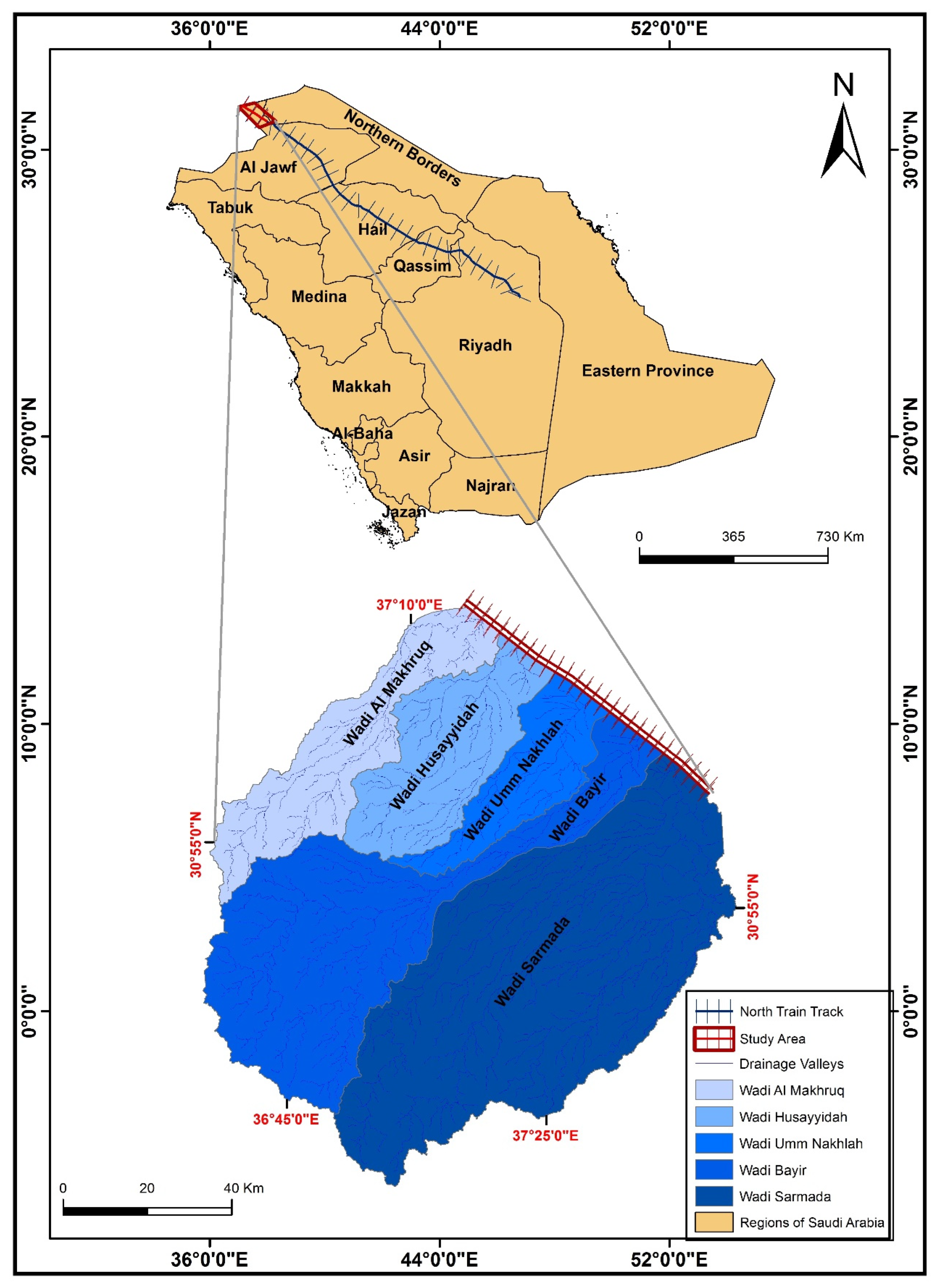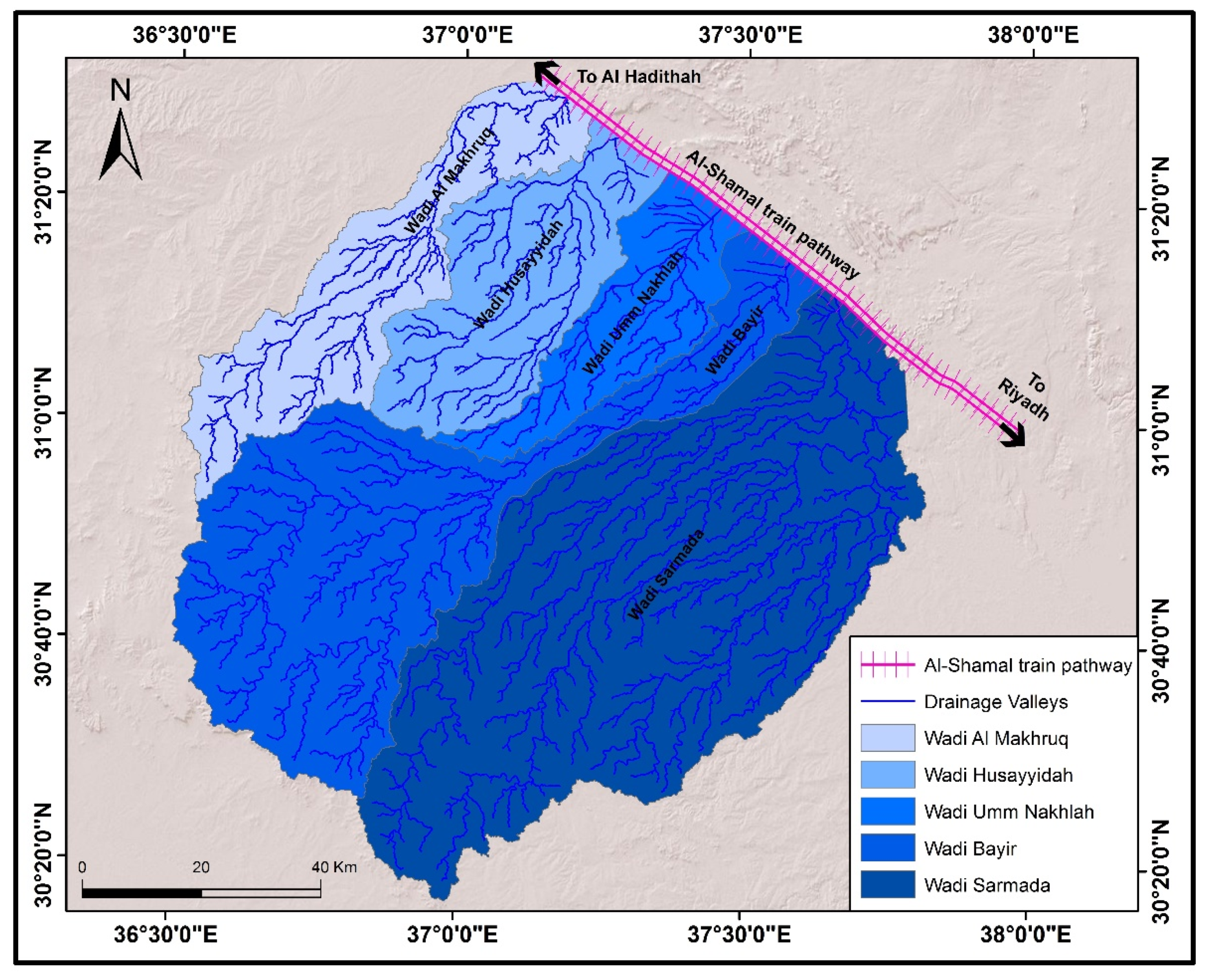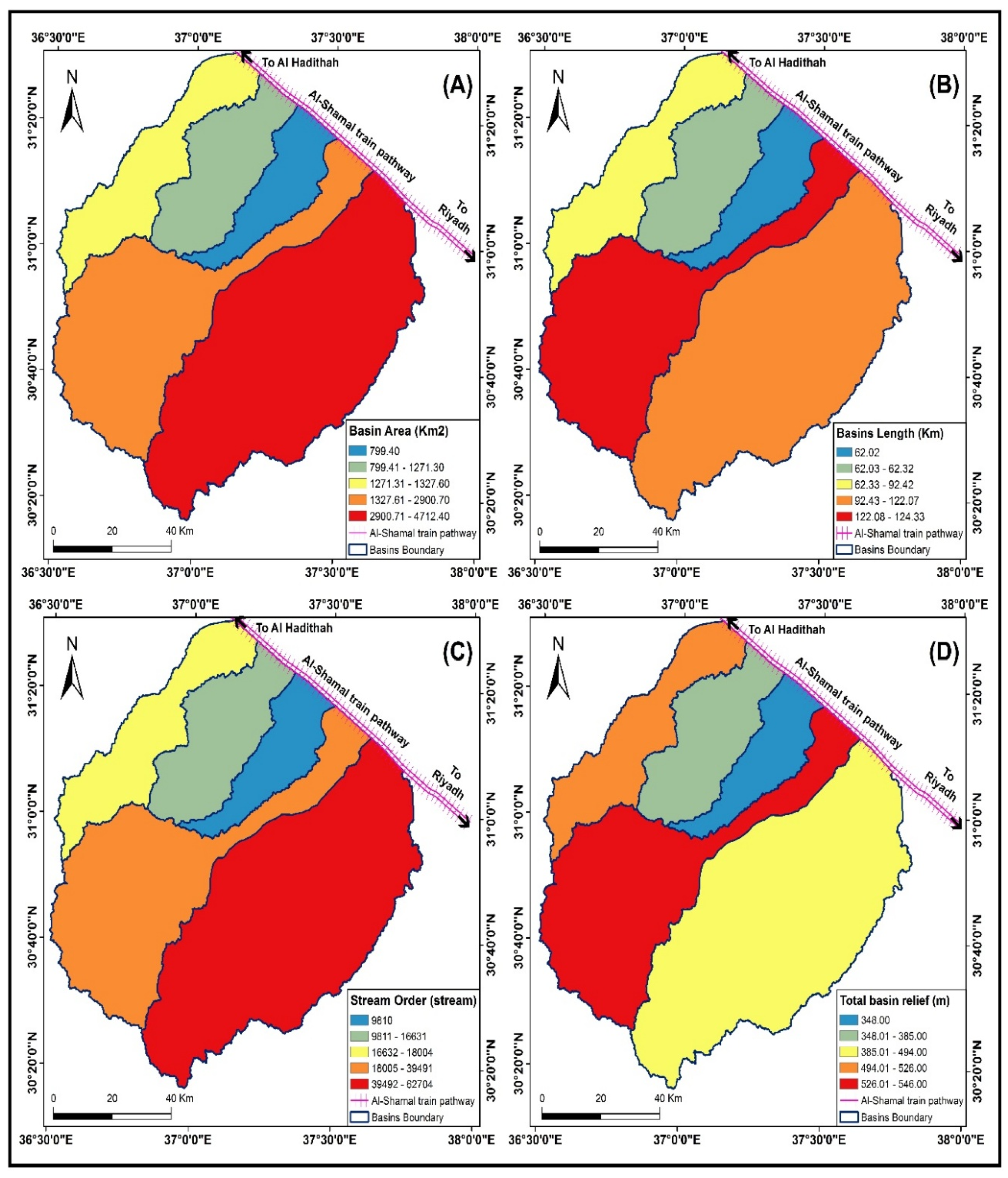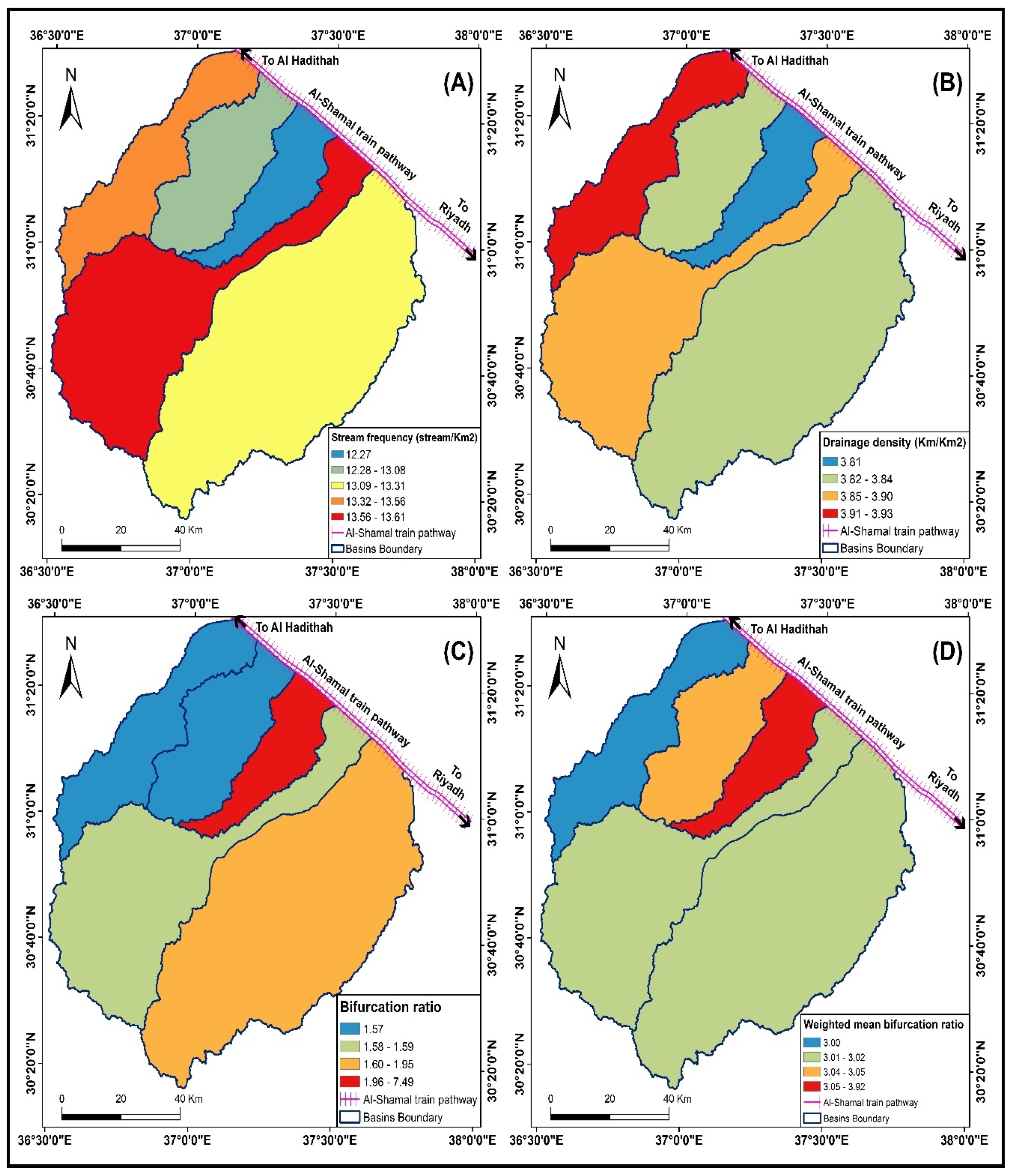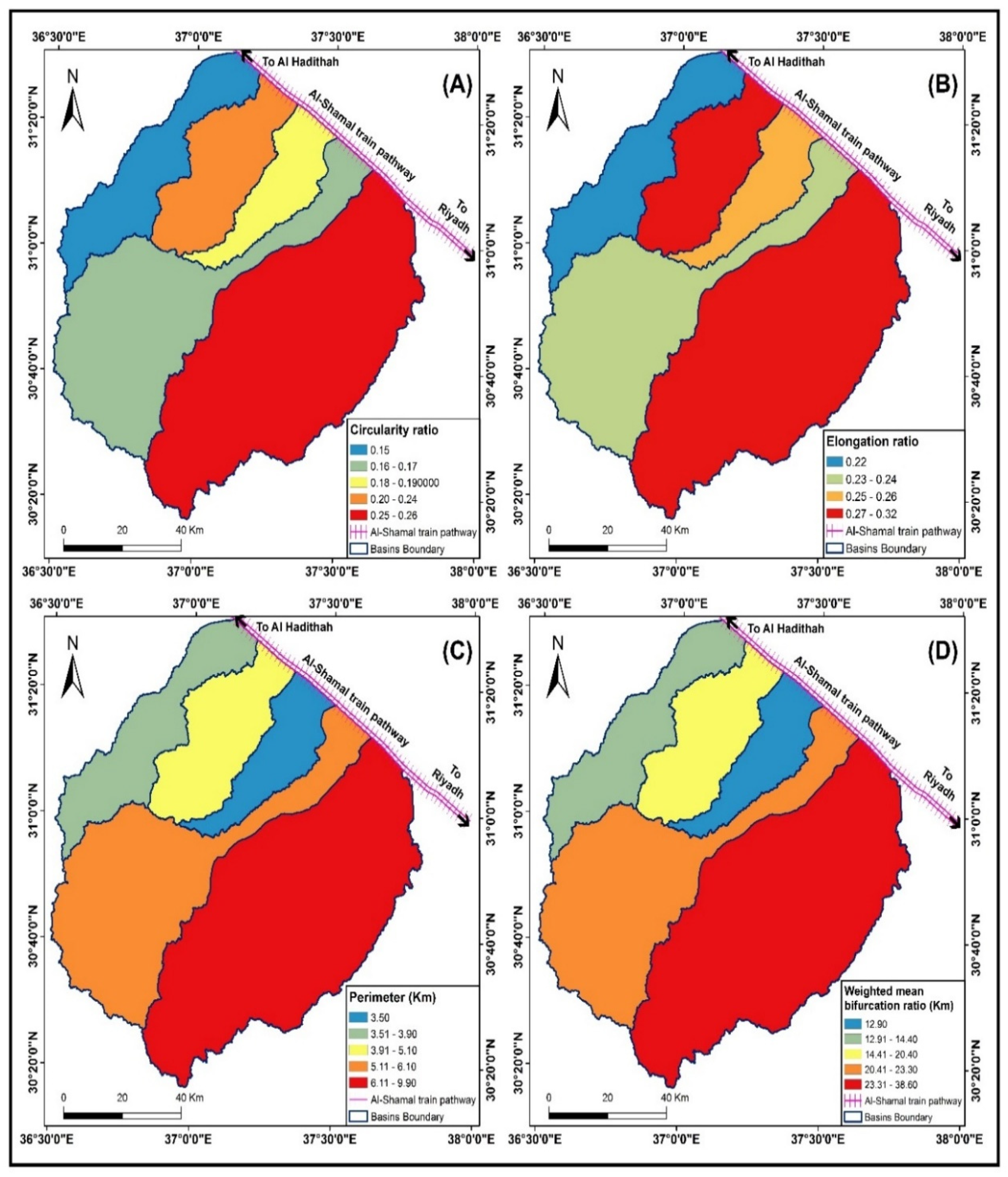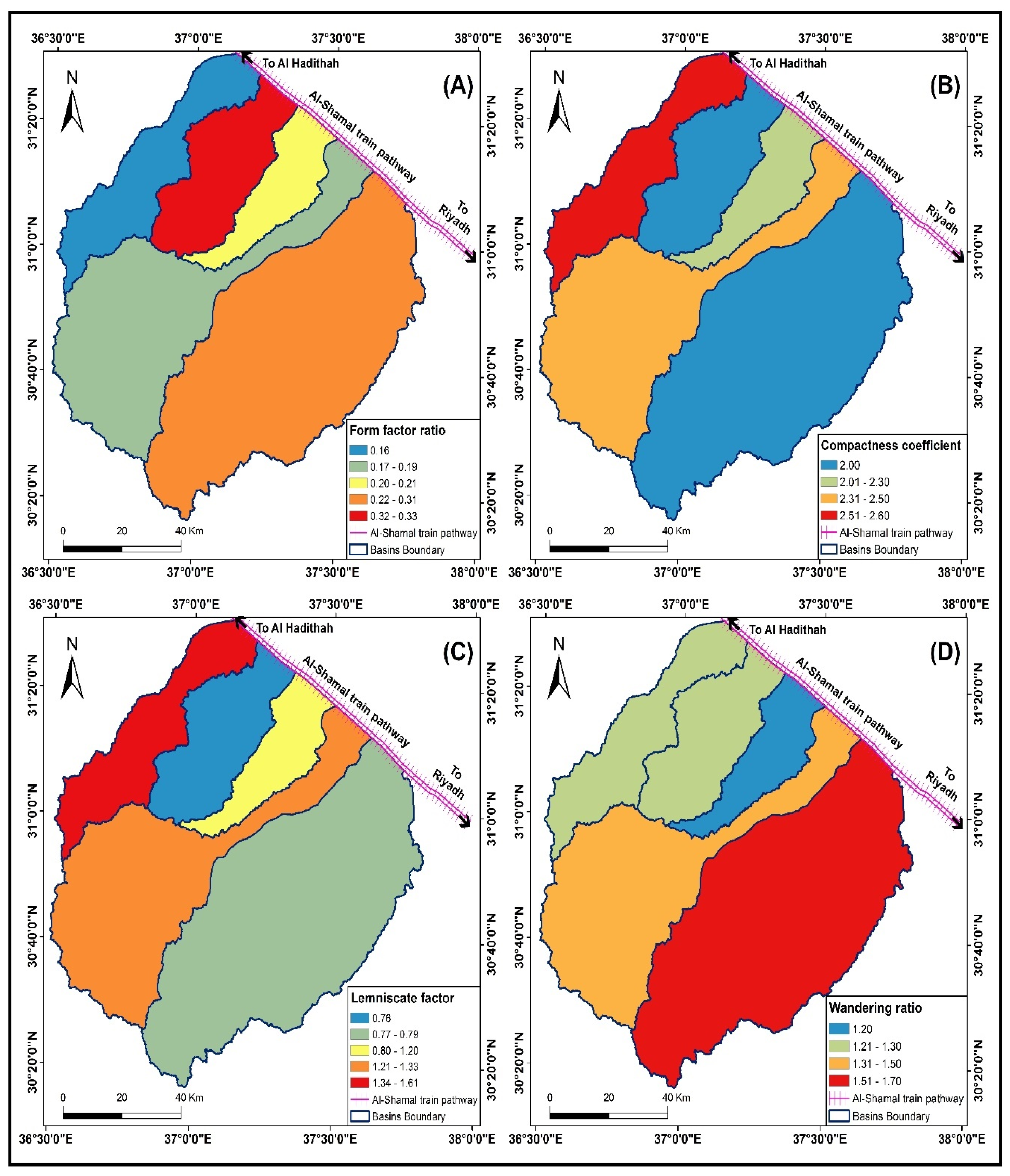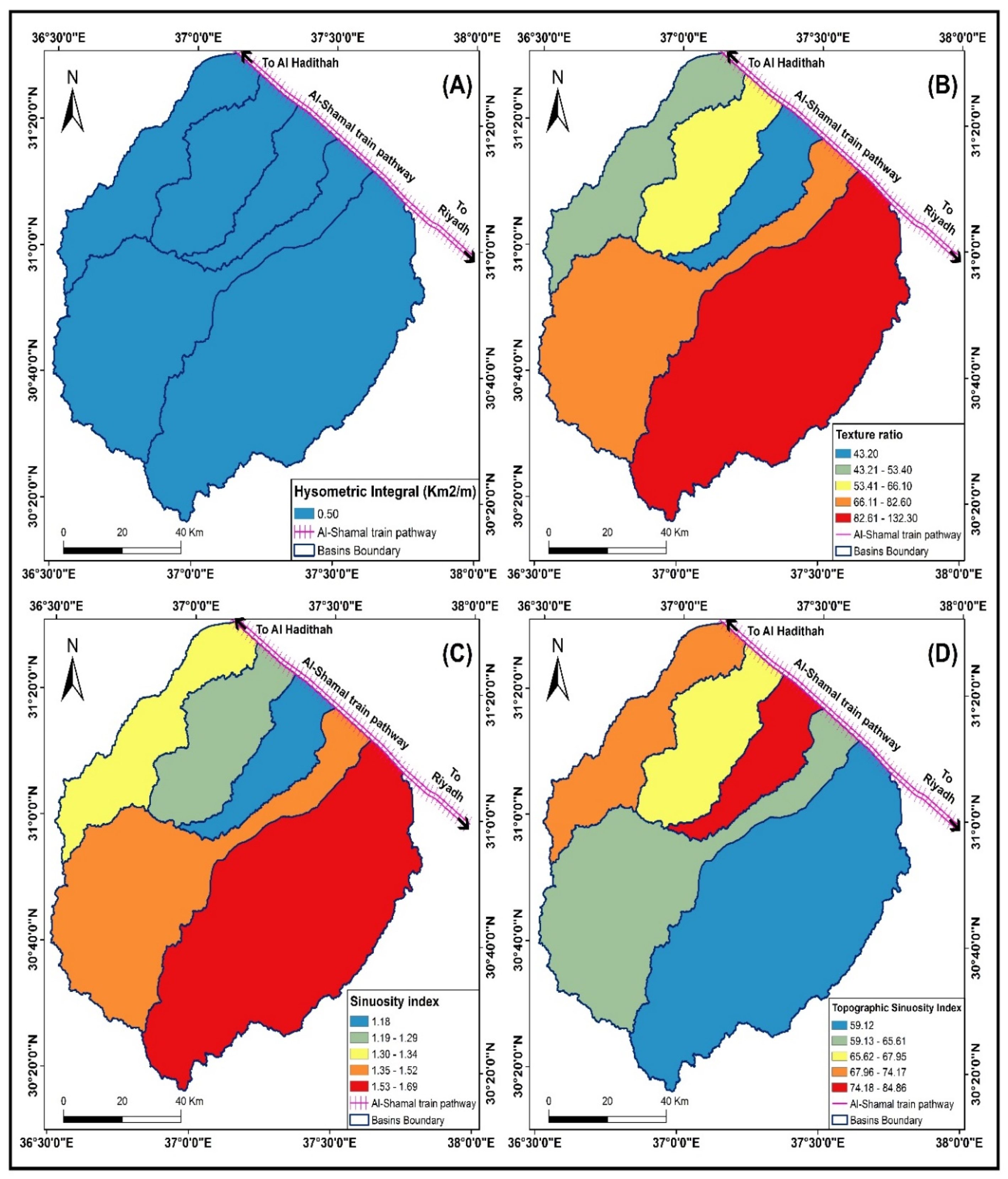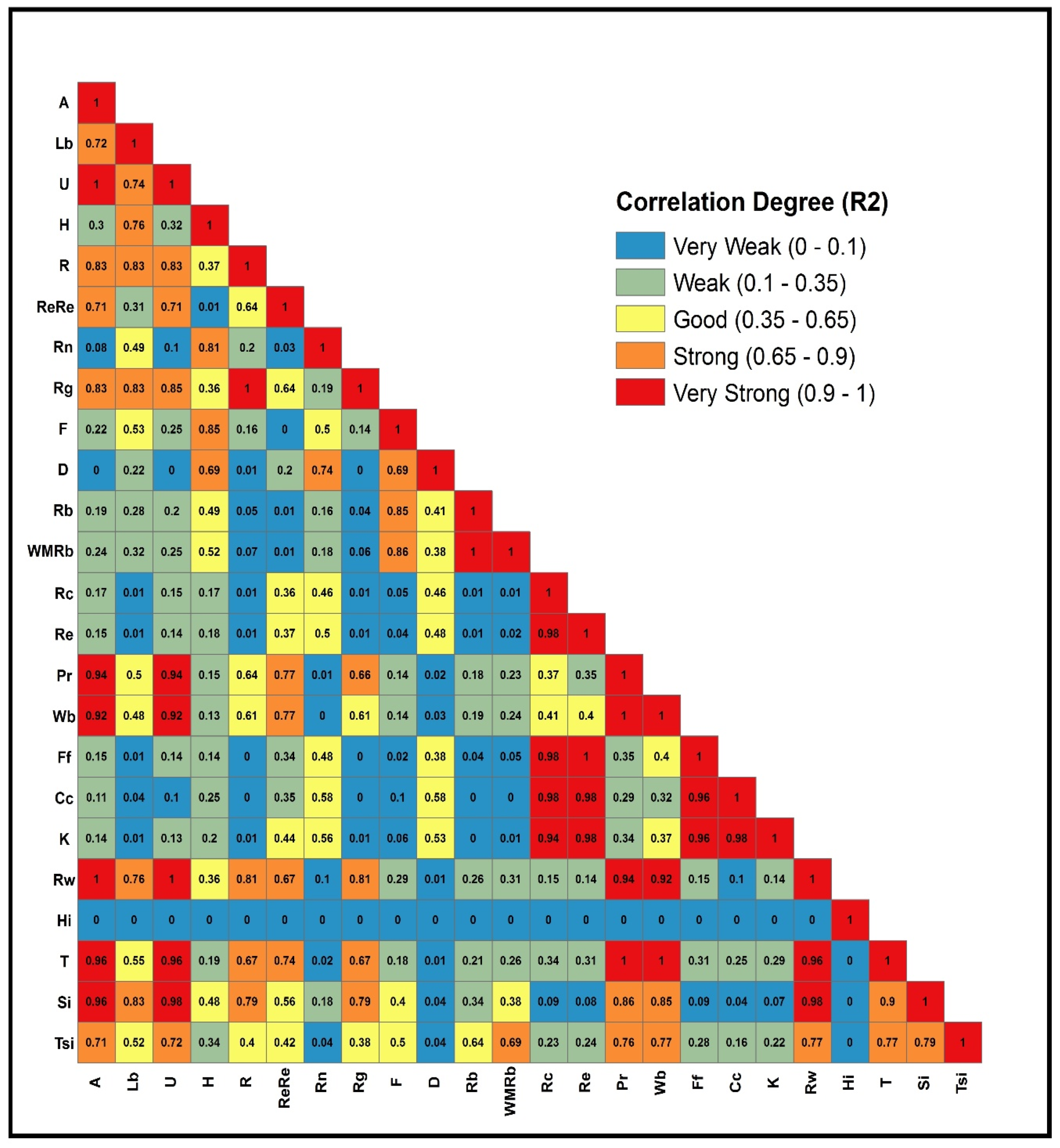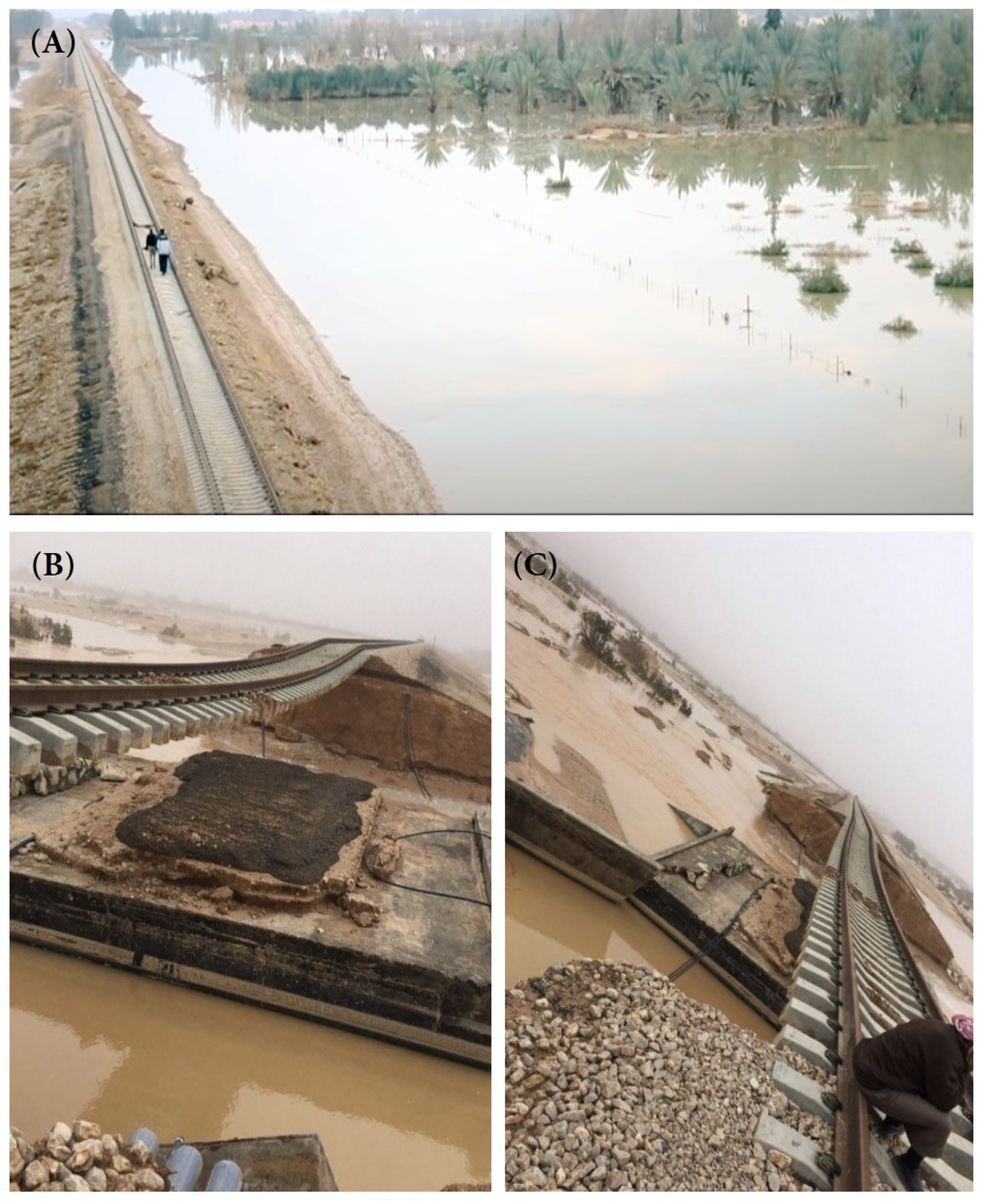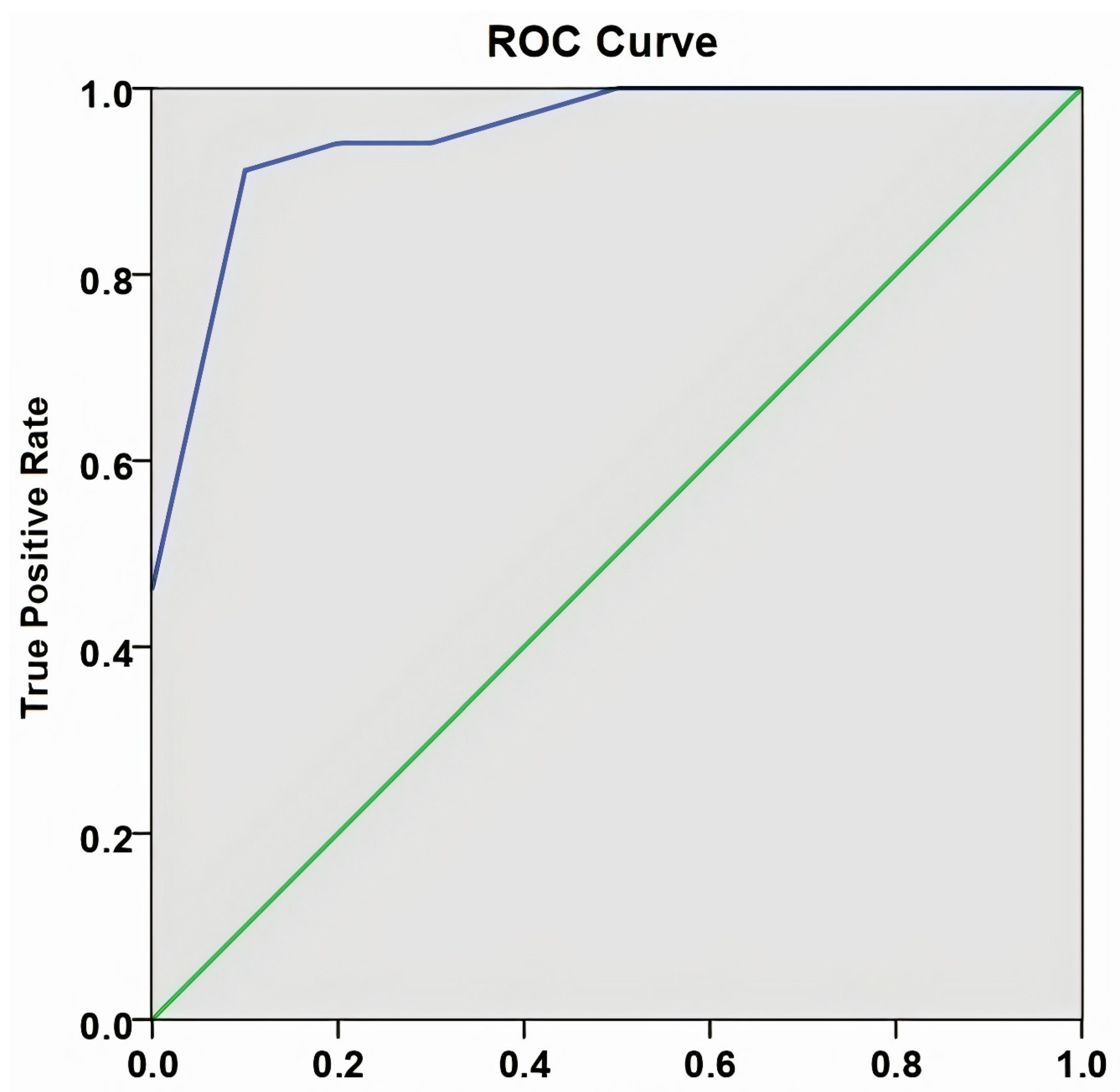4.1.3. Analysis of the Geomorphometric Characteristics
The values of the different geomorphometric criteria for the drainage sub-basins were calculated using the WMS and ArcGIS software.
Table 5 and
Figure 8,
Figure 9,
Figure 10,
Figure 11,
Figure 12 and
Figure 13 present the values of the different geomorphometric criteria for the drainage sub-basins.
- I.
The Total Area of the Basin
The total area of the basin is an indication of the basin’s dimensions and volume [
54]. The total area of the basin is an important component for calculating many other geomorphometric parameters, such as drainage density, stream frequency, shape factor, elongation ratio, circularity ratio, and compactness coefficient [
61]. The total area of the drainage sub-basins that affect the Al-Shamal train line is 799.4 km
2 in the Umm Nakhleh Hasidah basin and 4712.4 km
2 in the Sarmadaa basin.
- II.
Basin Length
The length of the basin determines the distance that the tributary network travels from the upper sources to the estuaries. It also indicates the formal parameters such as the shape of the basin, the form factor, and the elongation ratio. The length of the basin exceeds its width when the basin has the approximate shape of a rectangle and its elongation ratio increases, and vice versa [
62,
63]. The lengths of the drainage sub-basins affecting the Al-Shamal train line range from 62.02 km in the basin of Hasidah Umm Nakhleh to 124.33 km in the basin of Bayer.
- III.
Number of Streams
The number of tributaries in a drainage basin is an indicator of the severity of flooding in the basin. In addition, it is an indicator of other geomorphometric parameters, including the frequency of tributaries. A greater number of tributaries is a sign of high erosion rates and high drainage density with a lower bifurcation ratio [
64]. The total number of streams of the drainage basins on the Al-Shamal train line ranges from 9810 streams in the basin of Hasidah Umm Nakhla and 62,704 streams in the basin of Sarmadaa.
- IV.
Total Basin Relief
Total basin relief is defined as the difference between the highest and lowest elevation of the basin. The value of the total basin relief is an indication of the relief, slope, and erosion rates [
54,
65]. Higher values of total basin relief indicate significant variation in basin depths, high slope, and increase in erosion rates. The total basin relief of the drainage sub-basins affecting the Al-Shamal train line ranges between 348 m in the basin of Hasidah Um Nakhla and 546 m in the basin of Bayer.
- V.
Relief Ratio
The relief ratio is the ratio between the difference in the drainage basin and the length of the drainage basin. The relief ratio is an indication of relief, slope, and erosion rates [
54,
65]. A higher relief ratio indicates a large variation in basin depth, severe slope, and increasing erosion rates. The relief ratio of the drainage sub-basins affecting the Al-Shamal train pathway ranges between 4.05 m/km in the basin of Sarmadaa and 6.18 m/km in the basin of Hasidah Algharbya.
- VI.
Relative Relief
Relative relief is defined as the ratio between the difference in the drainage basin and the circumference of the drainage basin. Relative relief indicates relief, slope, and erosion rates [
54,
65]. Higher values of relative relief indicate large differences in basin depths, severe slopes, and increased erosion rates. The relative relief values of the drainage basins on the Al-Shamal train line range between 0.8 m/km in the basin of Sarmadaa, and 1.15 m/km in the basins of Hasidah Algharbya and Hasidah Umm Nakhla.
- VII.
Ruggedness Number
The ruggedness number is defined as the product of the drainage density and the difference in the depth of the drainage basin divided by a constant value. The ruggedness number is an indication of relief, drainage density, slope, soil erosion rates, and rock structure [
62,
63].
The ruggedness number is the product of the relief ratio and drainage density. Higher values of the ruggedness number indicate an increase in high relief ratio, an increase in the drainage density, heterogeneity in the geological structure, and high soil erosion rates. The values of the ruggedness number in the drainage sub-basins which affect the Al-Shamal train line range between 1.75 in the basin of Hasidah Algharbya and 2.11 in the basin of Makhrouq.
- VIII.
Gradient Ratio
The gradient ratio is defined as the ratio between the difference of the depths in the drainage basin and the length of the drainage basin [
66]. The gradient ratio affects all geomorphometric characteristics of the water drainage properties, including the amount of surface runoff, intrusion rates, drainage intensity, flood severity, and erosion rates. The gradient ratios for drainage sub-basins affecting the Al-Shamal train pathway range from 4 in the basin of Sarmadaa to 6.2 in the basin of Hasidah Algharbya.
- IX.
Stream Frequency
Stream frequency is defined as the ratio between the total number of tributaries in a drainage basin and the area of the drainage basin. The frequency of the tributaries indicates relief, intrusion rates, and permeability, and has a direct relationship with the drainage density [
62,
63,
67]. Stream frequency depends on the structure of the rocks and the type of vegetation. Drainage basins containing dense forests and tributaries with a solid geological structure appear in drainage networks with low stream frequency. Conversely, drainage basins that contain agricultural land and weak geological structures have high stream frequency [
68]. The frequency of the tributaries for the drainage sub-basins affecting the Al-Shamal train line ranges from 12.27 streams/km
2 in the basin of Hasidah Umm Nakhla to 13.61 streams/km
2 in the basin of Bayer.
- X.
Drainage Density
Drainage density is defined as the ratio between the lengths of all tributaries in a drainage basin and the area of the drainage basin. The drainage density refers to relief, geology, extent of soil erosion, and water drainage [
63,
69]. Higher values of drainage density indicate steep slopes [
70] with semipermeable solid geology, rough texture, and favorable conditions for groundwater conservation [
69,
71]. The density of the water discharge of the drainage sub-basins affecting the Al-Shamal train line ranges between 3.81 km/km
2 in the basin of Hasidah Umm Nakhla and 3.93 km/km
2 in the basin of Makhrouq.
- XI.
Bifurcation Ratio
The bifurcation ratio is defined as the ratio between the total number of tributaries in a particular order and the total number of the tributaries in the next order [
63,
66]. The bifurcation rate indicates the shape of the basin and the response to erosion, in addition to the geological structure of the area. A higher bifurcation rate represents a rectangular basin and a high erosion rate, whereas a lower bifurcation rate represents a circular basin and a low erosion rate [
62,
71]. The bifurcation ratios of the drainage sub-basins that affect the Al-Shamal train line range between 1.57 in the basins of Makhrouq and Hasidah Algharbya, and 7.49 in the basin of Hasidah Umm Nakhla.
- XII.
Weighted Mean Bifurcation Ratio
The weighted mean bifurcation ratio is more accurate than the bifurcation ratio, as it takes into account the numbers of tributaries in each stream order in the drainage basin. This ratio is more likely to be consistent than the bifurcation ratio [
63,
66]. Higher values of the bifurcation ratio represent a rectangular basin and a high erosion rate, while lower bifurcation ratio values represent a circular basin and a low erosion rate [
62,
66]. The weighted mean bifurcation ratios of the drainage sub-basins affecting the Al-Shamal train line range from 3 in the basin of Makhrouq to 3.92 in the basin of Hasidah Umm Nakhla.
- XIII.
Circularity Ratio
The circularity ratio is defined as the ratio between the area of the drainage basin and the square of the basin circumference to a fixed value (12.57), and indicates that the basin has a circular shape. The circularity ratio denotes the form parameters [
64], rates of discharge and erosion [
66], and the geomorphological and relief features [
58]. The circularity ratio is influenced by other factors such as lengths and frequency of tributaries, geological structure, land uses, climate, relief, and basin slope [
63,
65,
72]. The circularity ratio for drainage sub-basins affecting the Al-Shamal train line ranges from 0.15 in the basin of Makhrouq to 0.26 in the basin of Sarmadaa.
- XIV.
Elongation Ratio
The elongation ratio is defined as the ratio between the length of a circle’s diameter with the same area of the basin and the length of the basin, and indicates a rectangular basin shape. The elongation ratio indicates the form parameters, the erosion rate, intrusion, and runoff. Higher values of the elongation ratio indicate significant erosion, intrusion, and low runoff [
62,
65,
68]. The elongation ratio of the drainage sub-basins affecting the Al-Shamal train line range between 0.22 in the basin of Makhrouq and 0.32 in the basins of Hasidah Algharbya and Sarmadaa.
- XV.
Basin Perimeter
The basin perimeter of a drainage basin is defined as the ratio between the area of a basin and its perimeter. The basin perimeter indicates the length of the outer limits of the drainage basin relative to the area and thus determines other geomorphometric factors such as volume, shape, and drainage density. The upper values of the basin perimeter indicate a large basin size, a lower perimeter, and a high drainage density [
52]. The basin perimeters of the subdrainage basins affecting the Al-Shamal train line range from 3.5 km in the basin of Hasidah Umm Nakhla to 9.9 km in the basin of Sarmadaa.
- XVI.
Mean Basin Width
The mean basin width determines the permissible amplitude of the basin branches, and the dividing line represents its start and end [
62]. Mean basin width refers to morphological parameters such as basin form, form factor, and elongation ratio. The lower value of the mean basin width indicates a rectangular basin shape and a greater elongation ratio [
62,
63]. The average width of the drainage sub-basins affecting the Al-Shamal train line ranges from 12.9 km in the basin of Hasidah Umm Nakhla to 38.6 km in the basin of Sarmadaa.
- XVII.
Form Factor
The form factor is defined as the ratio between the area of the drainage basin and the square of the length of the basin. The form factor indicates the shape, volume, and length of the basin. Rectangular drainage basins are represented by a lower value for the form factor parameter, whereas round drainage basins are represented by a higher value for the form factor [
61]. The form factor for the sub-basins affecting the Al-Shamal train line range from 0.19 in the basin of Bayer to 0.33 in the basin of Hasidah Algharbya.
- XVIII.
Compactness Coefficient
The compactness coefficient is defined as the ratio between the circumference of the basin and the circumference of a circle that has an area equal to the drainage area of the same basin. The compactness coefficient indicates the erosion rate, in which higher compactness coefficient values indicate significant erosion rates. The compactness coefficient depends on the volume and slope of the drainage basins [
66]. The compactness coefficient of the drainage sub-basins affecting the Al-Shamal train line range between 2.0 in the basins of Hasidah Algharbya and Sarmadaa to 2.6 in the basin of Makhrouq.
- XIX.
Lemniscate Factor
The shape of the drainage area is wide in the upper basin and gradually narrows towards the lower basin. Chorleye proposed the lemniscate factor to express this geometrical characteristic of drainage basins. The lemniscate factor is defined as the ratio between the square of the basin length and four times the area of the basin. The lemniscate factor of the drainage sub-basins affecting the Al-Shamal train line ranges from 0.76 in the basin of Hasidah Algharbya to 1.61 in the basin of Makhrouq.
- XX.
Wandering Ratio
The wandering ratio is defined as the ratio between the length of the main stream that represents the distance the water travels from the source to the promontry, and the ideal length of the stream that represents the shortest distance from the source to the promontory.The wandering ratio indicates the extent of erosion, the geological composition, and the surface runoff speed. Higher values of the wandering ratio represent a high erosion rate, weak geological structure, and low surface runoff speed [
61,
62]. The wandering ratio at the drainage sub-basins that affect the Al-Shamal train line ranges between 1.2 in the basin of Hasidah Umm Nakhla and 1.7 in the basin of Sarmadaa.
- XXI.
Hypsometric Integral
The hypsometric integral is defined as the ratio between the average difference between the mean and the lowest depths, and the relief range. The hypsometric integral represents a time scale that expresses a phase though which the wadis of the rivers pass. The value of the hypsometric integral of all the drainage sub-basins affecting the Al-Shamal train line is a constant value equal to 50 km2/m.
- XXII.
Texture Ratio
Texture ratio is defined as the ratio between the total number of tributaries and the basin perimeter. The average of the texture refers to the amount and speed of runoff [
64]. Higher values of the texture ratio indicate surface degradation and, therefore, slow surface runoff and increased intrusion rate [
64]. The average of the texture ratio for the drainage sub-basins affecting the Al-Shamal train line range from 43.2 in the basin of Hasidah Umm Nakhla to 132.3 in the basin of Sarmadaa.
- XXIII.
Sinuosity Index
The sinuosity index is defined as the ratio between the length of the main stream that represents the distance the water travels from the source to the promontory and the length of the basin. The sinuosity index indicates the extent of the responses to erosion, the geological composition of the area, and the speed of runoff. Higher values of the sinuosity index represent a large erosion rate, weak geological structure, and low runoff speed [
62,
71]. The sinuosity index of the drainage sub-basins affecting the Al-Shamal train line range between 1.18 in the basin of Hasidah Umm Nakhla and 1.69 in the basin of Sarmadaa.
- XXIV.
Topographic Sinuosity Index
Topographic sinuosity index is defined as the share, expressed as a percentage, of the length of the drainage basin subtracted from one to the length of the main stream that represents the distance the water travels from the source to the promontory subtracted from one. The topographical sinuosity index of the drainage sub-basins affecting the Al-Shamal train line range between 59.12 in the basin of Sarmadaa and 84.86 in the basin of Hasidah Umm Nakhla.
